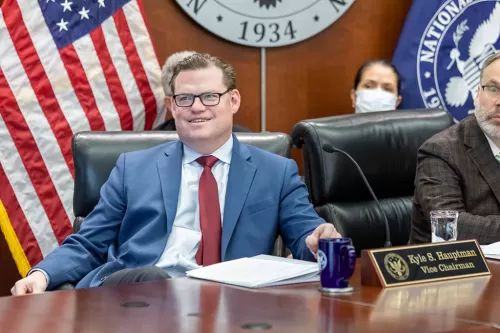NCUA Vice Chairman Kyle S. Hauptman during an open Board meeting in 2022.
As Prepared for Delivery on December 15, 2022
Thank you, Mr. Chairman, and thanks to Amanda, David, and Andy for the briefing.
Just to review, the Normal Operating Level (NOL), as described in the Federal Credit Union Act, can be set by the NCUA Board from 1.20 percent to 1.50 percent. The NOL is our desired level of equity in the Share Insurance Fund. The NCUA Board has the discretion to assess a premium when the equity ratio falls below 1.30, but only to bring the ratio up to 1.30 as allowed by the Federal Credit Union Act.
The 1.33 Normal Operating Level represents the point at which the Share Insurance Fund is required to return funds back to insured credit unions should the equity ratio exceed 1.33. Now a few months back, I voted, along with the rest of the Board, to lower the NOL to 1.33 from 1.38, where it had been for several years. Now I don’t pretend to know that 1.33 is the magic, perfect Net Operating Level. I do know that, for the moment, moving it from 1.38 to 1.33 is a moot point because the Fund isn’t close to either number. And if someday we wind up back in that range, the correct NOL level will be a high-class problem to worry out. Given the current rate environment, I do not believe any of us believes we will be getting close to that number. That said, every basis point over 1.30 represents money credit unions could put to good use.
I appreciate the additional information on how the Normal Operating Level is calculated. We need more of this kind of transparency. In the spirit of more transparency, I ask that we acknowledge our responsibility to show why 1.30 is not adequate — as I said, every basis point over 1.30 is money credit unions could be investing in their members.
It’s worth emphasizing that credit unions are doing their part. I would like us to recognize this fact via finding ways to factor actual losses incurred into our loss reserves calculation. After all, the higher the loss reserves, the lower the equity ratio. More importantly, the actual losses incurred year-over-year may be a decent predictor of the fund’s reserve needs. But of course, I acknowledge that insurance isn’t about normal circumstances. The whole point of insurance is for the unexpected, the unusual, the chaotic.
One additional factor in determining the adequate level of the fund’s equity is how well we manage our budget. Coincidentally, the budget is also on today’s agenda. The cost of managing the risk in the fund directly impacts the equity ratio. The more NCUA spends on itself, the lower the equity ratio. NCUA can’t, in good conscience, spend additional millions on programming for ourselves, the 4 1,200 NCUA employees, while also claiming our Insurance Fund needs more cash.
I realize today’s briefing is strictly about the Normal Operating Level calculation, but I hope you’re picking up what I’m putting down.
Lastly, I’d like to recall our meeting in January of 2021, right after the second COVID stimulus bill was passed. At the time, the equity ratio had dropped considerably due to all that cash flooding the country, creating billions in deposits that NCUA had to insure. Our other problem back then was how little we were earning on our investments since Treasury yields were so low. But at that meeting, two years ago, I suggested that one of those problems might help fix the other. What I said was that all the stimulus spending because it was entirely deficit-financed, (i.e., all that spending was with money the government borrowed) that spending should push Treasury yields higher, thus our new investments would start earning higher interest rates.
I just want to note that that is, in fact what has happened. The real world doesn’t always immediately follow textbook economics. But the laws of economics eventually prevail, since economics is like physics: for every action there is an equal and opposite reaction. I also understand why people make fun of us economist types for always saying “on the one hand, this will happen, but on the other hand…” That’s why President Truman said, “Find me a one-handed economist.”
Thank you, Mr. Chairman, this concludes my remarks. I have a couple of questions.
So, in your presentation, I believe you indicated that the cumulative 5-year losses during the hypothetical moderate recession scenario would be around $540 million in total. How does that compare to last year’s estimate of losses during the five-year window?
Can you point to a time when a 1.30 percent NOL wasn’t sufficient, and what did we do to make up the difference?
Can you provide some additional rationale as to why we may need to set the normal operating level higher than 1.30 percent?



